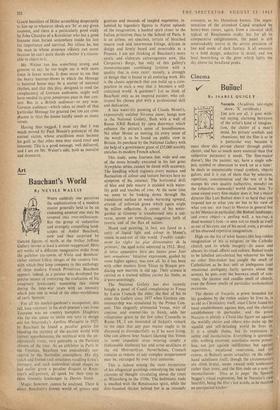Art
Bauchant's World
By NEVILE WALLIS
WHEN suddenly one perceives the sophistication of a modern master generally held to be an endearing amateur one may be tempted into over-enthusiasm. But the group of unfamiliar and strangely compelling land- scapes of Andre Bauchant, now and then surprised by tranced figures of myth, at the Arthur Jeffress Gallery invites at least a serious reappraisal. Here are works of a different imaginative order from the guileless toy-towns of Vivin and Bombois' rather sinister folksy images of the country fair, with which they keep company in this anthology of three modern French Primitives. Bauchant appears, indeed, as a painter who developed the precise means of conveying the exaltation of his imaginary landscapes, sustaining this vision during the inter-war years with an intensity which puts one in mind of the other-worldliness of early Spencer.
For all his market-gardener's occupation, this tall, lean visionary in his drab peasant's suit from Touraine was no country bumpkin. Diaghilev was far too astute to invite any tyro to design sets for Stravinsky's Apollon Musagete in 1927. In Bauchant he found a peculiar genius for blending the mystery of the ancient world with current apprehensions, the mythical with the un- obtrusively ironic, very palatable in the Parisian climate of the time. As an exhibitor in Paris in the Twenties, Bauchant was undoubtedly sus- ceptive to the Surrealist atmosphere. His dry touch and fretted rock structures recalling Ernst's frottages, and such malevolent cloud shapes as had earlier given a peculiar disquiet to Rous- seau's self-portrait, all speak for their time in these fantastic landscapes in Davies Street.
Magic, however, cannot be analysed. There is about Bauchant's frozen world of groves and
grottoes and mounds of tangled vegetation, in- habited by legendary figures in Alpine uplands of the imagination, a hushed spirit closer to the Italian primitives than to the School of Paris. It is an airless, yet spacious, terrain of bleached mauve rock and interwoven foliage, delicate in design and firmly based and penetrable as a Poussin. I am not thinking of Bauchant's more exotic and elaborate extravaganzas now, like Cleopatra's Barge, but only of this gallery's mountainscapes combining lyricism with a quality that is even rarer; namely, a strength of design that is found in all enduring work. His is the classic approach that can build up a com- position in such a way that it becomes a self- contained world A gardener? Let us think of Bauchant only as an inspired painter, who cul- tivated his chosen plot with a professional skill and dedication.
A late water-lily painting of Claude Monet's, expressively entitled Nirvana terrine, hangs now in the National Gallery, flush with a wall of Room XXII flanked by open doorways which enhance the picture's sense of boundlessness. No other Monet so moving (in every sense of the word) is to be found on public view in Britain. Its purchase by the National Gallery with the help of a government grant of £35,000 notably enriches its modern French school.
This study, some fourteen feet wide and one of the more broadly executed in his last great Nympheas series, cannot be dated with accuracy. The handling which registers every nuance and fluctuation of colour and texture betrays here no symptom of his cataract. The horizontal drift of blue and pale mauve is studded with water- lily gold and touches of rose. At the same time we seem to be looking down through the translucent surface to weeds wavering upward, strands of yellowish green which again might be willow reflections. A corner of his water- garden at Giverny is transformed into a uni- verse, serene yet tremulous, suggestive both of reverie. and of the flux of nature.
Mood and painting, in fact, are fused in a unity of liquid light and colour in Monet's vision in-and-out of this world. 'J'oublie totale- ment les regles les plus elementaires de la peinture,' the aged artist admitted in 1912. 'Bret, je laisse apparaitre hien des fatties pour fixer mes sensations.' Intuitive expression, guided by some higher agency, was now all. So it has been with other masters from Titian to Braque pro- ducing new marvels in old age. Their science is carried, as a trained athlete carries his limbs, as it were unwittingly.
The National Gallery has also recently bought a panel of Cupid complaining to Venus by Lucas Cranach the elder, the first of his to enter the Gallery since 1857 when German con- noisseurship was stimulated by the Prince Con- sort. This elegantly attenuated Venus, wiry of contour and enamel-like in finish, adds her voluptuous gface to the few other Cranachs in Room IX. I am reminded of Sickert's remark to me once that any past master ought to be discussed as disrespectfully as if he were living. One can almost hear Sickert likening this Venus to some impudent siren wearing simply a fashionable feathered hat and some necklaces at the old Metropolitan. Nevertheless, Cranach remains as remote as any complex temperament may be, estranged by over four centuries.
This is indeed among the most mysterious of his allegorical paintings embodying the varied currents of thought circulating about the court at Wittenberg in the 1530s. The hedonistic nude is touched with the Renaissance spirit, while the deer-haunted thicket behind her is as intensely romantic as his Danubian forests. The repre- sentation of the attendant Cupid attacked by honey-bees comes, again, from a classical idyll typical of Renaissance study; but for all its comparative enlightenment, the panel is still unmistakably native in the severe precision of line and mode of dark fantasy. It all amounts to a bold design, seductive in detail, and not least bewitching in the glow which lights the sky above far headland peaks.






























 Previous page
Previous page